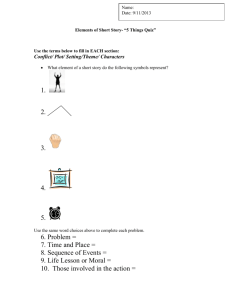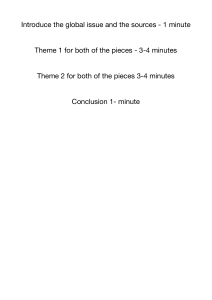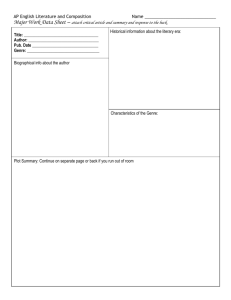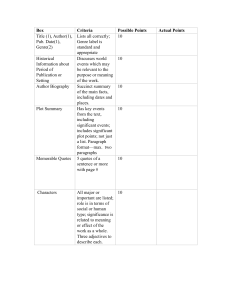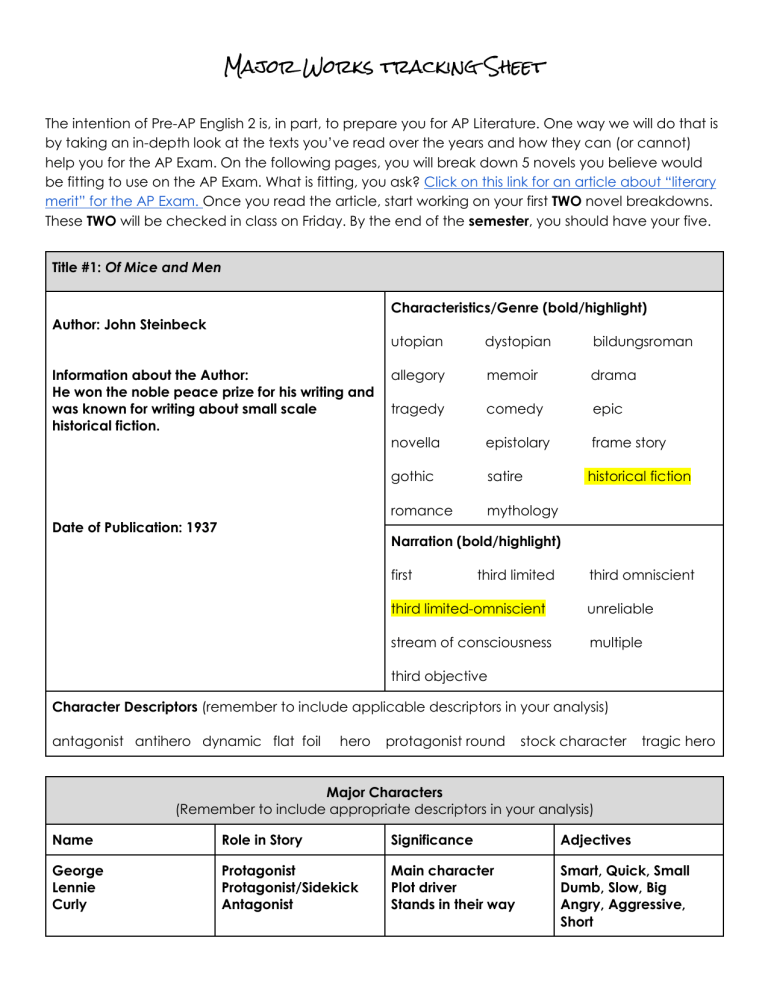
Major Works tracking Sheet The intention of Pre-AP English 2 is, in part, to prepare you for AP Literature. One way we will do that is by taking an in-depth look at the texts you’ve read over the years and how they can (or cannot) help you for the AP Exam. On the following pages, you will break down 5 novels you believe would be fitting to use on the AP Exam. What is fitting, you ask? Click on this link for an article about “literary merit” for the AP Exam. Once you read the article, start working on your first TWO novel breakdowns. These TWO will be checked in class on Friday. By the end of the semester, you should have your five. Title #1: Of Mice and Men Characteristics/Genre (bold/highlight) Author: John Steinbeck Information about the Author: He won the noble peace prize for his writing and was known for writing about small scale historical fiction. Date of Publication: 1937 utopian dystopian bildungsroman allegory memoir drama tragedy comedy epic novella epistolary frame story gothic satire historical fiction romance mythology Narration (bold/highlight) first third limited third omniscient third limited-omniscient unreliable stream of consciousness multiple third objective Character Descriptors (remember to include applicable descriptors in your analysis) antagonist antihero dynamic flat foil hero protagonist round stock character tragic hero Major Characters (Remember to include appropriate descriptors in your analysis) Name Role in Story Significance Adjectives George Lennie Curly Protagonist Protagonist/Sidekick Antagonist Main character Plot driver Stands in their way Smart, Quick, Small Dumb, Slow, Big Angry, Aggressive, Short Setting General Description of Setting: Set during the dust bowl on a farm in the 1930s. Significance of Opening Scene: Shows the bond and friendship between George and Lennie. Significance of Closing Scene: George has to kill his friend for the greater good which hurts him. Symbols Identification of Symbols: The Puppy Candys Dog Rabbits Significance of Symbols: Lennie can’t control strength and hurts others Society needs to move on from the old to new Shows the dream of a nice, peaceful life Meaning of the Work as a Whole (Theme) Theme Roots/Subjects Explored: Theme Statements (corresponding to the root): Dreams are just dreams Their dream was the only thing to keep them going and happy Friendship No matter what, George and Lennie had each other Freedom Vs. Captivity Everyone wants their own land but they have to work on others Title #2: To Kill a Mockingbird Characteristics/Genre (bold/highlight) Author: Harper Lee Information about the Author: She won a pulitzer price and studied law. Date of Publication: July 1960 utopian dystopian bildungsroman allegory memoir drama tragedy comedy epic novella epistolary frame story gothic satire historical fiction romance mythology Narration (bold/highlight) first third limited third omniscient third limited-omniscient unreliable stream of consciousness multiple third objective Character Descriptors (remember to include applicable descriptors in your analysis) antagonist antihero dynamic flat foil hero protagonist round stock character tragic hero Major Characters (Remember to include appropriate descriptors in your analysis) Name Role in Story Significance Adjectives Scout Jem Atticus Boo Narrator/Protagonist Brother/Protagonist Father/Protagonist Elusive figure She questions society Helps Scout with things Guides children Scars then saves kids Curious, Helpful, Kind Loyal, Brave, Honest Wise, Firm, Brave Kind, Thin, Timid Setting General Description of Setting: Small rural town in 1930s Significance of Opening Scene: Introduces us to the characters and show Scout/Jem bond Significance of Closing Scene: Shows us Boo is a good guy and that he shouldn’t go to jail Symbols Identification of Symbols: Mockingbird Mad Dog Radley House Significance of Symbols: They sing and do good so we shouldn’t harm Represents injustice and things Atticus fights Scary at first but instead is home to a kind man Meaning of the Work as a Whole (Theme) Theme Roots/Subjects Explored: Theme Statements (corresponding to the root): The right thing doesn’t always win Racism is bad but it’s what everyone knows so no change Don’t judge a book by it’s cover Everyone was afraid of Boo but he was a very good man Children know more than some Scout was more wise than most of the town at only 8 years old Title #3: Characteristics/Genre (bold/highlight) Author: Information about the Author: Date of Publication: utopian dystopian bildungsroman allegory memoir drama tragedy comedy epic novella epistolary frame story gothic satire historical fiction romance mythology Narration (bold/highlight) first third limited third omniscient third limited-omniscient unreliable stream of consciousness multiple third objective Character Descriptors (remember to include applicable descriptors in your analysis) antagonist antihero dynamic flat foil hero protagonist round stock character Major Characters (Remember to include appropriate descriptors in your analysis) Name Role in Story Significance Adjectives tragic hero Setting General Description of Setting: Significance of Opening Scene: Significance of Closing Scene: Symbols Identification of Symbols: Significance of Symbols: Meaning of the Work as a Whole (Theme) Theme Roots/Subjects Explored: Theme Statements (corresponding to the root): Title #4: Characteristics/Genre (bold/highlight) Author: Information about the Author: Date of Publication: utopian dystopian bildungsroman allegory memoir drama tragedy comedy epic novella epistolary frame story gothic satire historical fiction romance mythology Narration (bold/highlight) first third limited third omniscient third limited-omniscient unreliable stream of consciousness multiple third objective Character Descriptors (remember to include applicable descriptors in your analysis) antagonist antihero dynamic flat foil hero protagonist round stock character Major Characters (Remember to include appropriate descriptors in your analysis) Name Role in Story Significance Adjectives tragic hero Setting General Description of Setting: Significance of Opening Scene: Significance of Closing Scene: Symbols Identification of Symbols: Significance of Symbols: Meaning of the Work as a Whole (Theme) Theme Roots/Subjects Explored: Theme Statements (corresponding to the root): Title #5: Characteristics/Genre (bold/highlight) Author: Information about the Author: Date of Publication: utopian dystopian bildungsroman allegory memoir drama tragedy comedy epic novella epistolary frame story gothic satire historical fiction romance mythology Narration (bold/highlight) first third limited third omniscient third limited-omniscient unreliable stream of consciousness multiple third objective Character Descriptors (remember to include applicable descriptors in your analysis) antagonist antihero dynamic flat foil hero protagonist round stock character Major Characters (Remember to include appropriate descriptors in your analysis) Name Role in Story Significance Adjectives tragic hero Setting General Description of Setting: Significance of Opening Scene: Significance of Closing Scene: Symbols Identification of Symbols: Significance of Symbols: Meaning of the Work as a Whole (Theme) Theme Roots/Subjects Explored: Theme Statements (corresponding to the root):
